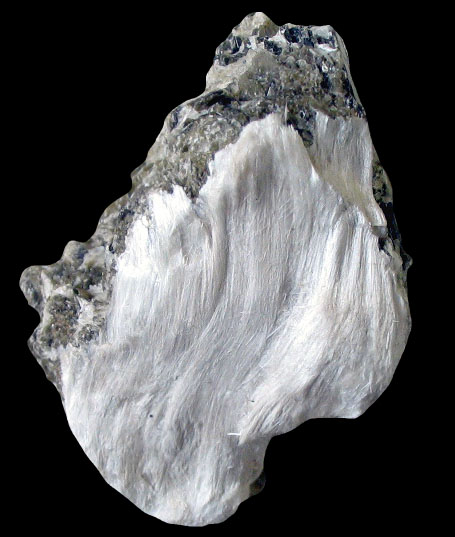Asbestos Exposure
What is asbestos? How was it used? Where was I exposed?

Steel mills, chemical and power plants, and similar industrial workplaces are some of the most common locations for asbestos exposure. For every worker that knew their pipe covering, gaskets, roofing felts, or fireproofing spray contained asbestos, there are many more that had no idea. Many workers were unaware they were working with or near asbestos products until their asbestos cancer diagnosis.
For others, their bystander asbestos exposure comes from shaking out their father's dusty work clothes.
What is asbestos?
At it's most basic, asbestos is a rock mined from the earth.
More accurately, asbestos is a naturally occurring silicate mineral found on nearly every continent on the earth. Asbestos has long been used for its weavable fibers and resistance to heat. Ancient Greeks describe funeral shrouds woven from asbestos that allowed the ashes of the body to be kept separate from the funeral pyre's ashes. The term "asbestos" comes from an Greek word meaning unquenchable or indestructible.
Although the word "asbestos" refers to several similar minerals, it is not a geological term, but a commercial one. The six minerals that have been used in commercial and/or industrial applications are collectively referred to as asbestos; other minerals with similar qualities that have not been exploited by industry are referred to as "asbestiform."
MINERAL VS. ROCK?
A mineral is an inorganic, naturally occurring substance of a single type of matter. A rock is made up of various minerals and other naturally occurring substances.
Asbestos is a mineral, but it is not found in pure concentrations. When asbestos is mined, it is mixed with contaminates such as dirt, rocks, and other minerals.
Types of Asbestos
| Asbestos Mineral Name | About | Common Uses |
|---|---|---|
| Chrysotile | Serpentine type asbestos, white fibers. The most commonly used asbestos; as of 2000, it makes up 99% of the world’s current asbestos production | Textiles, woven brake linings, clutch pads, and marine insulation |
| Cummingtonite-grunerite | Amphibole type asbestos, brown asbestos, Amosite (trade name; acronym for Asbestos Mines of South Africa). No longer mined | Insulation, ceiling tiles, vinyl tiles, roof sections, wall panels, and water pipes |
| Riebeckite, Crocidolite | Amphibole type asbestos, blue asbestos. No longer mined. | Insulation, ceiling tiles, vinyl tiles, roof sections, wall panels, and water pipes. Also filters for gas masks and cigarettes |
| Anthophyllite | Amphibole type asbestos, very rarely mined. | Paint and sealants |
| Actinolite | Amphibole type asbestos, very rarely mined. | Drywall and joint compounds |
| Tremolite | Amphibole type asbestos. Not generally mined, but found as a contaminant in vermiculite (as in Libby, MT) | Vermiculite is used as a soil conditioner and loose-fill insulation material |
Asbestos: fibrous silicates
Asbestiform minerals are defined by their chemical and physical characteristics. All varieties of asbestos are chemically silicates and physically fibrous. The fibrous and dusty nature of asbestos is a large part of why asbestos was so widely used, and why it is so dangerous.
Asbestos Fibers

Microscopic asbestos fibers shown by a Scanning Electron Microscope (asbestos image courtesy of the U.S. Geological Survey).
Asbestos fibers were often used as a lightweight filler material, but lightweight asbestos fibers are also easily airborne, making for dusty working conditions where inhalation or ingestion of fibers was very likely. The long, thin fibers that are so characteristic of asbestos allow it to be woven into fabric, but these fine fibers also enable asbestos to slice into the delicate tissues of lungs. Finally, the tensile strength of asbestos meant it was often mixed with other materials for reinforcement, but this strength overpowers the body's natural defenses making asbestos fibers impossible to break down.
Asbestos has been used by man for centuries. The first recorded use for asbestos was to add lightweight strength to ceramic pots and utensils in Finland in 2500 B.C. The modern use of asbestos, however, didn't take off until the industrial revolution. Asbestos use grew exponentially worldwide and within the US.
Perhaps most interesting about all this modern asbestos use is that the risks appeared almost as soon as the "miracle mineral" was used in any amount. Disease and injury in asbestos factories was being discussed by 1898. First asbestosis, then lung cancer, and finally mesothelioma were all attributed to asbestos. By the early 1960s, there was not much argument to be made on behalf of asbestos.
It is hard to believe then, that asbestos use in the U.S. continued to rise for another decade. Even today, asbestos is not banned and it is still imported into the United States.
